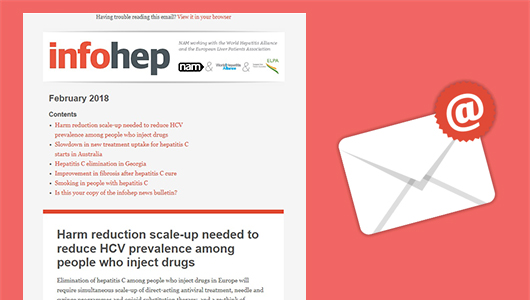Having trouble reading this email? View it in your browser
| |
October 2021 | |
Cognitive function improves after hepatitis C cure
fizkes/Shutterstock.com Cognitive impairment covers a wide spectrum of problems with memory, concentration, learning, attention span, decision-making ability and difficulties with mental tasks in everyday life. Some people with hepatitis C refer to these problems as ‘brain fog’. Cognitive impairment is more commonly observed in people with cirrhosis. In people with decompensated cirrhosis, it is an early sign of the onset of hepatic encephalopathy. As cognitive impairment has a significant effect on quality of life, Spanish researchers wanted to find out whether direct-acting antiviral treatment reduced cognitive impairment. Learning that curing hepatitis C can reduce cognitive impairment might also encourage people to overcome their reluctance to start direct-acting antiviral treatment. The study evaluated cognitive changes in 135 people cured of hepatitis C between 2015 and 2017. Thirty-two per cent had cirrhosis. At study entry, 34% of people with cirrhosis and 14% without cirrhosis had cognitive impairment. Cognitive impairment was associated with arterial hypertension and hepatic encephalopathy. A greater number of years of education was associated with a reduced risk of cognitive impairment. After eradication of hepatitis C, people with cirrhosis showed significant improvements in measures of motor function, executive function, processing speed, attention and global cognitive function. They also showed improvements in Psychometric Hepatic Encephalopathy Scores. People with cirrhosis also experienced significant improvements in mood and some measures of health-related quality of life. However, people with cirrhosis at baseline still displayed worse cognitive performance than people without cirrhosis 48 weeks after completing treatment. Cognitive function also improved in people without cirrhosis. Improvement in cognitive function was significantly greater in people with cognitive impairment at baseline, especially those with worse cognitive impairment, and in older patients. The study authors conclude that curing hepatitis C can improve cognitive function regardless of liver disease stage, with the greatest benefits in older people and those with lower brain reserve. Related linksNew cases of hepatitis C have fallen among gay and bisexual men with HIV in France
Domizia Salusest | www.domiziasalusest.com To assess the possible impact of direct-acting antiviral treatment on hepatitis C incidence in France, researchers looked at hepatitis C incidence in the ANRS-CO4-FHDH cohort, a nationally representative cohort of people living with HIV receiving care at 175 hospitals in France between 2014 and 2017. Hepatitis C treatment using second-generation direct-acting antivirals was available without restriction to people living with HIV throughout the study period. The researchers identified 14,273 gay or bisexual men in the cohort who attended a clinic between 2014 and 2017, had a negative hepatitis C antibody test within two years prior to inclusion in the analysis and a subsequent hepatitis C antibody test between 2014 and 2017. From this cohort they calculated hepatitis C incidence between 2014 and 2017, assuming that all selected participants were tested every six months according to French guidelines. During the follow-up period, 330 new hepatitis C infections were diagnosed, an overall incidence of 0.76 cases per 100 person-years of follow-up. The number of infections declined each year, from 101 in 2014 to 54 in 2017, and the incidence rate fell by 54% between 2014 and 2017. Incidence fell by 33% between 2016 and 2017. The French group say their findings match observations in the Netherlands and the United Kingdom after the introduction of direct-acting antivirals. But they warn that although further scale-up of treatment would lead to greater reductions in hepatitis C incidence, increases in hepatitis C transmission among HIV-negative gay and bisexual men in France could halt progress towards hepatitis elimination, due to shared sexual networks. They say that risk reduction strategies for gay and bisexual men living with HIV and for HIV-negative men are also needed to limit hepatitis C virus incidence. Related linksRapid hepatitis C treatment improves cure rate in young people who inject drugs
Jair Lazaro/Unsplash A simplified, same-day treatment model led to a higher cure rate compared with usual care for young people who inject drugs, according to research presented at the virtual IDWeek meeting. However, less than two-thirds were cured – well below rates seen in other studies of easier-to-treat groups. Direct-acting antiviral therapy for hepatitis C virus (HCV) is highly effective, producing sustained virological response rates upwards of 90% in clinical trials. But outcomes may not be as good in the real world because some people do not start or complete treatment. Young people who inject drugs have a high incidence of HCV infection but lower rates of treatment initiation compared with their older peers, presenter Professor Benjamin Eckhardt of New York University School of Medicine noted as background. Therefore, simplified care models are needed to engage, treat and cure this population. Previous research has shown good outcomes for simplified treatment with minimal monitoring. HCV-Seek Test & Rapid Treatment (HCV-ST&RT) was a randomised trial comparing rapid treatment versus usual care for young injection drug users age 18 to 29 years. Antibody screening took place as part of the Staying Safe study, focused on HCV prevention for this population. The study enrolled and randomised 38 young people. Those in the rapid treatment group received a same-day medical evaluation, a confirmatory HCV RNA test and baseline lab tests and were given a seven-day starter pack of sofosbuvir/velpatasvir (Epclusa). They were scheduled for further visits on day 7 for side effects monitoring and to receive another 21-day supply of pills; on day 28 for lab work and to receive their final 56-day pill supply (for a total of 12 weeks of therapy); and at 12 weeks post-treatment for follow-up testing. Those in the usual care group also received a confirmatory HCV test, but if they tested positive, they were referred to local providers to manage their care and treatment. Four people in the rapid treatment group and nine in the usual care group tested negative for HCV RNA, indicating that they likely naturally cleared the virus; they were not treated or included in the analysis. In the rapid treatment group, 12 out of 14 (85.7%) completed treatment and nine achieved sustained virological response. In contrast, just five of the 11 participants in the usual care group had an initial visit and baseline lab work. Of these, three started treatment. Only one person completed treatment and was cured. Among young people who inject drugs who tested positive for HCV RNA, "significantly higher rates of cure were achieved using the Rapid Treatment model with same day, low-threshold, simplified HCV care compared to facilitated referral," the researchers concluded. People with HIV taking newer antiretrovirals at higher risk of fatty liver disease
Blue_Deep/Shutterstock.com Non-alcoholic fatty liver disease (NAFLD) develops through accumulation of fat in the liver. People with diabetes and/or high body mass are more likely to develop fatty liver, or steatosis. One in four people in North America and Europe is estimated to have fatty liver disease but estimates of prevalence in people with HIV vary enormously. A small proportion of people with fatty liver disease go on to develop non-alcoholic steatohepatitis (NASH), an inflammatory state that can lead to severe liver damage (cirrhosis). NASH increases the risk of developing liver cancer (hepatocellular carcinoma), but the risks of progression from NAFLD to NASH, to cirrhosis and liver cancer in people with HIV are unclear. Jenny Bischoff and colleagues at University Hospital Bonn carried out a prospective cohort study to investigate the prevalence of fatty liver disease and risk factors for the development of fatty liver disease in people with HIV not co-infected with hepatitis C. Amongst other factors, they wanted to investigate whether weight gain associated with antiretroviral treatment raised the risk of fatty liver disease. The study recruited 319 people and followed them for an average of three-and-a-half years. Six per cent of study participants had type 2 diabetes at baseline, 20% had high blood pressure and 46% already had some degree of steatosis, including 17.5% who had severe steatosis and 13.8% who had advanced steatosis. During the follow-up period, 20% of participants either developed steatosis or progressed to a more advanced stage of steatosis. Among those followed for five years, only 36% remained free of steatosis by the end of the study period, compared with 54% at study entry. The proportion with severe steatosis increased from 17.5% to 50% over the same period. Thirty per cent of all participants with steatosis at baseline experienced a worsening of steatosis grade during the follow-up period. The risk of developing steatosis was more than seven times greater in people with type 2 diabetes than those without. The risk was also elevated in people taking tenofovir alafenamide (TAF), an integrase inhibitor and in those with a lowest-ever CD4 count below 200. The study also found that participants taking TAF or an integrase inhibitor developed steatosis more quickly or experienced more rapid progression than people taking other drugs. They also had a higher risk of weight gain of 5% or 10% than other participants. In contrast, people taking tenofovir disoproxil fumarate (TDF) had a significantly lower risk of developing steatosis or experiencing progression of steatosis compared to people not taking the drug. They also had a lower risk of weight gain compared to people not taking TDF. The study investigators conclude that weight gain associated with antiretroviral regimen and the development of steatosis are linked and that TDF may play a role in protecting against both weight gain and steatosis. They recommend that people with HIV with a body mass index above 23, and anyone taking TAF or an integrase inhibitor, should undergo Fibroscan screening and other testing to establish the extent of liver damage. Related linksIs this your copy of the infohep news bulletin?
Is this your copy of the infohep news bulletin, or did you receive it from a friend or colleague, or find it online? You can sign up to receive this monthly email bulletin, free of charge, on our website, where you can also find an archive of all the infohep news bulletins. | |
| We are grateful to Abbvie, Bristol-Myers Squibb, Gilead and Janssen for funding infohep.org. Our funders have had no editorial control over the site’s content. | |
 Latest treatment news and information for patient advocates and people working in hepatitis in Europe. For more details, please contact: To unsubscribe please click here Privacy Policy |







Connect with infohep on Facebook: Keep up to date with all the latest news and developments.
Follow infohep on Twitter for links to news stories and updates from infohep.org. Follow us at www.twitter.com/infohep.
Follow all the infohep news by subscribing to our RSS feeds.